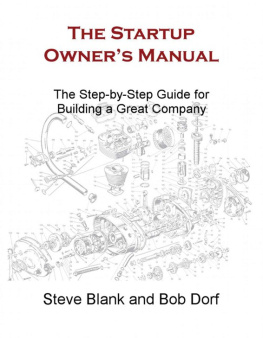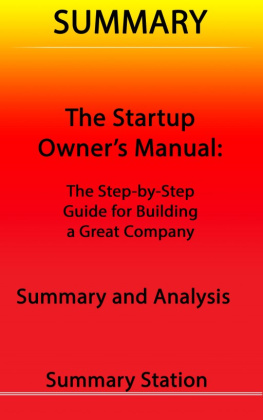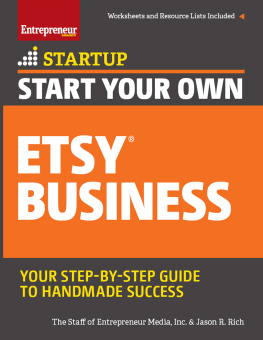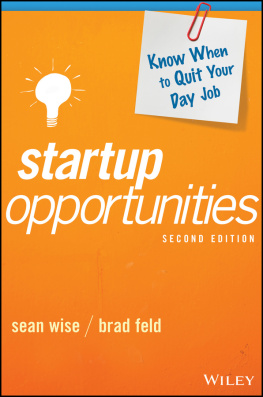Get Out of the Building!

The Startup Owners Manual
The Step-by-Step Guide for Building a Great Company
by Steve Blank and Bob Dorf
Copyright 2012 by K and S Ranch Inc., K&S Ranch Publishing Division
The Startup Owners Manual TM 2012. All Rights Reserved.
This publication is designed to provide accurate and authoritative information in regard to the subject matter covered. It is sold with the understanding that the publisher is not engaged in rendering legal, accounting or other professional services. If legal advice or other expert assistance is required, the services of a competent professional person should be sought.
All rights reserved. No part of this publication may be reproduced or transmitted in any form or by any means, electronic or mechanical, including photocopy, recording, or any information storage and retrieval system, without permission in writing from the publisher. For permission to copy of any part of the work, contact:
Published by:

K&S Ranch Press, div. K&S Ranch, Inc.
4100 Cabrillo Highway, Pescadero, California 94060
Visit our website at www.steveblank.com.
to contact K&S Ranch, email
Library of Congress Cataloging-in-Publication Data
ISBN: 978-0-9849993-7-8
Book design by Karrie Ross, www.KarrieRoss.com
First Edition: September 2012

QED stands for Quality, Excellence and Design. The QED seal of approval shown here verifies that this eBook has passed a rigorous quality assurance process and will render well in most eBook reading platforms.
For more information please click here.
About this Book
Welcome to The Startup Owners Manual e-book.
Here youll find all the tips, techniques and best practices that entrepreneurs need in their quest to build successful companies packaged to suit your startup teams particular path. This e-book organizes The Startup Owners Manual into three e-books to better help you navigate the text. In short:
- provides background on, and an overview of the Business Model and Customer Development processes
- e-book provides all the step-by-step process detail youll need to create a solid, sustainable startup doing business in the web/mobile channel, and
- e-book offers the same for startups using physical channels
For best results, start your reading with the Strategy Guide.
The Startup Owners Manual Strategy Guide makes up the first third of the e-book. It provides an overview of why startups are not smaller versions of large companies; explains how startups search for a business model using Customer Development; and details the overall customer development methodology, and key implementation steps.
For companies with virtual distribution channels, The Startup Owners Manual for Web/Mobile Channel Startups , the second part of the e-book, provides a similar detailed, step-by-step process and approach for startups that sell via the web or app stores channels, where things move faster, customers are abundant, and customer attention is always hard to get.
If youre building a startup with physical distribution channels, youll want to turn to the third part of this e-book, The Startup Owners Manual for Physical Channel Startups . This section provides detailed guidance, instructions, and examples on how to build a great company, step-by-step. Included are details on how to get, keep and grow your customer base; checklists for tracking progress; and tools to help determine just how successfulor notyou can be.
We believe the Startup Owners Manual can help you increase your odds of finding customers, a market, and product/market fit. Now, as we say, get of the building! And best of luck with your startup.
Steve and Bob
Table of Contents
Chapter 1:
The Path to Disaster: A Startup Is Not a Small Version of a Big Company
Chapter 2:
The Path to the Epiphany: The Customer Development Model
Chapter 3:
The Customer Development Manifesto.
Chapter 4:
An Introduction to Customer Discovery
Chapter 5:
Introduction to Customer Validation
Chapter 6:
Customer Validation: The Toughest Question of All: Pivot or Proceed?
Chapter 1:
The Customer Development Manifesto
Chapter 2:
An Introduction to Customer Discovery
Chapter 3:
Customer Discovery, Phase One:
State Your Business Model Hypotheses
Chapter 4:
Customer Discovery, Phase Two:
Get Out of the Building to Test the Problem: Do People Care?
Chapter 5:
Customer Discovery, Phase Three:
Get Out of the Building and Test the Product Solution
Chapter 6:
Customer Discovery, Phase Four:
Verify the Business Model and Pivot or Proceed
Chapter 7:
Introduction to Customer Validation
Chapter 8:
Customer Validation, Phase One:
Get Ready to Sell
Chapter 9:
Customer Validation, Phase Two:
Get Out of the Building and Sell!
Chapter 10:
Customer Validation, Phase Three:
Develop Product and Company Positioning
Chapter 11:
Customer Validation, Phase Four:
The Toughest Question of All: Pivot or Proceed?
Chapter 1:
The Customer Development Manifesto
Chapter 2:
An Introduction to Customer Discovery
Chapter 3:
Customer Discovery, Phase One:
State Your Business Model Hypotheses
Chapter 4:
Customer Discovery, Phase Two:
Get Out of the Building to Test the Problem: Do People Care?
Chapter 5:
Customer Discovery, Phase Three:
Get Out of the Building and Test the Product Solution
Chapter 6:
Customer Discovery, Phase Four:
Verify the Business Model and Pivot or Proceed
Chapter 7:
Introduction to Customer Validation
Chapter 8:
Customer Validation, Phase One:
Get Ready to Sell
Chapter 9:
Customer Validation, Phase Two:
Get Out of the Building and Sell!
Chapter 10:
Customer Validation, Phase Three:
Develop Product and Company Positioning
Chapter 11:
Customer Validation, Phase Four:
The Toughest Question of All: Pivot or Proceed?

The Startup Owners Manual Strategy Guide
Table of Contents
Chapter 1:
The Path to Disaster: A Startup Is Not a Small Version of a Big Company
Chapter 2:
The Path to the Epiphany: The Customer Development Model
Chapter 3:
The Customer Development Manifesto.
Chapter 4:
An Introduction to Customer Discovery
Chapter 5:
Introduction to Customer Validation
Chapter 6:
Customer Validation: The Toughest Question of All: Pivot or Proceed?
Preface
IN 1602, THE DUTCH EAST INDIA COMPANY, generally regarded as the first modern company, issued the first stock certificates. In the intervening 300 years, companies managed to start, build and grow without formally trained executives. By the 20th century, the complexity of modern corporations demanded a cadre of executives trained to administer large companies. In 1908, Harvard awarded the first master of business administration (MBA) degree to fill the need to bring professional education standards to big business. The MBA curriculum standardized and codified the essential elements an operating executive in a modern company needed to know: cost accounting, strategy, finance, product management, engineering, personnel management and operations.
Next page
















